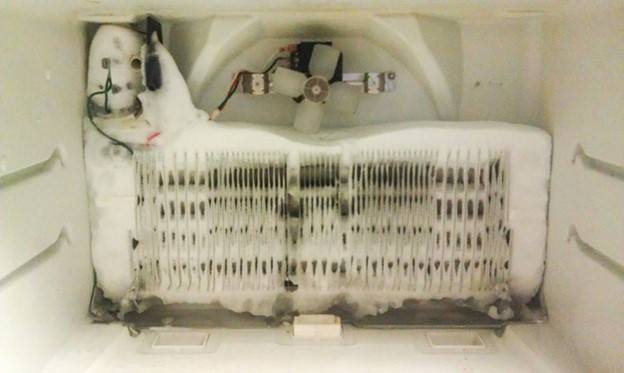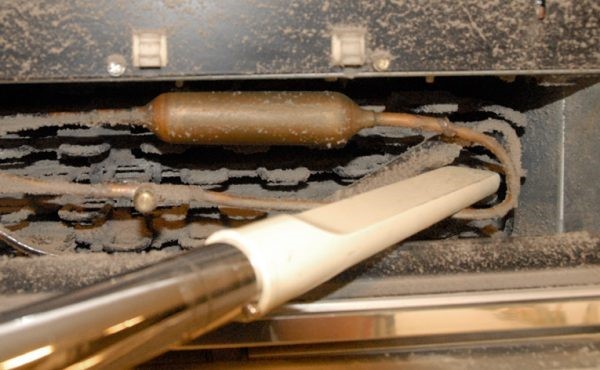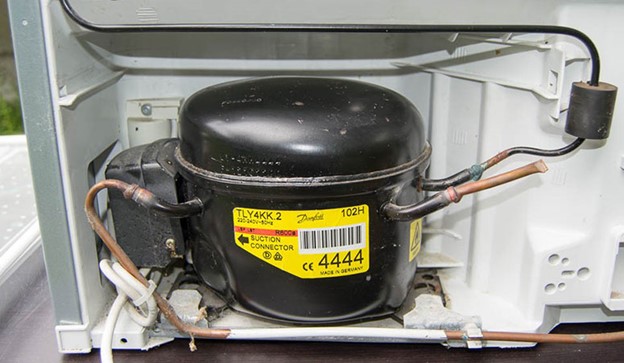Finding your refrigerator not cooling is a very frustrating moment, but maybe there is no need to replace your fridge. Here we are going to talk about some common reasons for refrigerator not cooling and we'll give you some solutions to overcome this problem.
Tip: if you study the article about refrigerator parts and components, you can easily get your appliance function and find out it's problem.
Frozen evaporator coils and refrigerator not cooling

Refrigerator warming can be a result of ice build up on evaporator coils. The ice is formed gradually and covers the coils like an insulation. So there isn't any air flow around the coils. The ice should be melted automatically (in frost-free refrigerators) or manually to let the refrigerator cool down again.
Tip: faulty refrigerator door gasket can also cause frost to build up on the evaporator coils.
Faulty evaporator fan makes the refrigerator not cooling

Fan circulates cool air all around the refrigerator. If the fridge has one evaporator, the evaporator is located in freezer compartment. If the fan doesn't work, there is no air flow. So, freezer is always cold but the refrigerator is not cooling.
Rotate the fan using your hands. If it can't spin freely, it should be replaced. If the fan motor has extra unusual noises, it should be replaced too. We have talked about refrigerator unusual noises before.
If the fan motor doesn't work, check the voltage with multimeter. In case of having appropriate voltage, replace the fan motor. If there isn't any voltage, the board is faulty and should be replaced.
Faulty defrost system stops the refrigerator from cooling
All frost-free refrigerators have a defrost system consisting of a timer and a heater.
Defrost timer changes the refrigerator mode from cooling to defrosting and vice versa. If the timer is faulty and stays on cooling mode, ice and frost build up on evaporator coils and restrict the air flow. If it is stuck on defrost mode, all the ice is melted and there will be no cooling.
Defrost heater melts down the ice and frost on evaporator coils. If it is faulty, the ice built up prevents the refrigerator from cooling.
If any of these two components are faulty, the cooling and defrost timing of the refrigerator is disrupted.
Compressor is the heart of the refrigerator. If it doesn't work well, the whole cooling process stops. Compressor gives the refrigerant enough pressure to circulate in refrigeration cycle. So, when the compressor breaks down, the whole refrigerator cycle stops and refrigerator doesn't cool down anymore.
Refrigerant shortage is a reason for refrigerator not cooling
As we mentioned above, compressor is the heart of the refrigeration system. So, refrigerant is the blood. If there isn't enough refrigerant in the system because of leaking or any other reason, the refrigerator cooling process is affected.
Condenser dirty coils affect the refrigerator cooling process

If condenser coils are dirty, covered by dust, the heat generated during refrigerant condensation can't leave the coils properly and reduces the refrigerator cooling power. There is an easy solution for this problem, using a special brush and vacuum cleaner to clean the coils.
Note: clean the refrigerator condenser coils at least twice a year to increase the compressor lifespan and make the refrigerator cool well.
Faulty condenser fan causes the refrigerator not to cool down
The condenser fan sends the heat out of the refrigerator condenser. If the fan is faulty and doesn't work, heat can't properly leave the system. So, the temperature inside the fridge goes up. Whether the problem is with the fan motor or its blades, it should be replaced.
Faulty start relay prevents the refrigerator from cooling down

Start relay is located near the compressor and helps it with starting. So, it is obvious if the relay is faulty, the compressor doesn't start, refrigeration cycle stops and there will be no refrigerator cooling down.
Faulty capacitor a reason for refrigerator not cooling down
The capacitor helps with improving the compressor function. So if it is faulty, the refrigeration cycle doesn't start. Use a multimeter to check the capacitor and replace it in case of any problem.
Faulty thermistor can make the refrigerator not cool down
Thermistor is a sensor that controls the temperature inside the refrigerator and also the start and end of the refrigeration cycle. If this component is faulty, the refrigerator doesn't cool at all or work continuously
Blocked dampers can cause the refrigerator not to cool down
Dampers control the flow of air from the freezer to the refrigerator. Blocked dampers will warm up the fridge compartment. Dampers can be blocked by the food inside the fridge or by the frost in refrigerators without any automatic defrost system.
Unlevel refrigerator can't cool down properly

If the refrigerator is not level, the door won't close properly and cool air will leak out. Adjust the refrigerator legs to level your appliance.
Tip: the refrigerator legs are usually adjustable using any kind of wrench.
Faulty door gasket affects the refrigerator cooling process
If all refrigerator components work well but the door gasket is faulty, cool air will leak out and causes frost built up on evaporator coils. So, the cooling process of refrigerator is disrupted. The door gasket should be replaced in this case.
Electricity cut is a reason for refrigerator not cooling
The simplest reason for refrigerator not cooling can be the electricity cut. The circuit breaker may be tripped or the fridge is unplugged.
Faulty thermostat doesn’t let the refrigerator cool down
The last reason for refrigerator not cooling is a faulty thermostat. Thermostat connects the voltage for compressor, evaporator fan and condenser. A faulty thermostat can stop the refrigeration cycle.
These are the 15 common reasons for refrigerator not cooling. If you want more information about refrigerator and refrigeration systems, don't miss the refrigerator training course in HelloTechnic website. Our experts will teach you everything about refrigerator installation, service, troubleshooting and repair, all through films and animations to make you a professional technician.



